top of page
Norris Locomotive Works
In our neighborhood, between 1834 and 1866, there was a locomotive builder that dominated local, regional, and national production. By 1840, 30% of its production was being exported. By 1850 it was the largest locomotive builder in the United States. This company formed the nucleus for the 19th century equivalent of today's Silicon Valley, an Iron Valley if you will. The company had a 30-year run and then was abandoned to be cannibalized by the Baldwin Locomotive Works and William Sellers.
The Norris Locomotive Works had its peak in the 1850's when it turned out one hundred locomotives per year and employed 1100 workers. It started when civil engineer, inventor, and explorer Stephen H. Long (1784-1864, Wikipedia entry here) began fiddling around trying to improve British steam locomotives, with no success. He was joined in 1833 by new Philadelphian William Norris, a dry-goods merchant with no engineering background but a good sales pitch. They organized in a stable as the American Steam Carriage Company next to Rush and Muhlenberg's Bush Hill Iron Shop at 16th and Buttonwood Streets (at that time Schuylkill 7th and Fairview Streets). They broke a hole into Rush and Muhlenberg's iron shop next door and ran a line-shaft for power into their six-man enterprise. In 1835 Colonel Long abandoned the business, which then became William Norris Locomotive Works. Norris, like immediate factory neighbor Matthias Baldwin, knew the future was in railroads. He had hired a real mechanical engineer, Joseph Harrison, in 1834, and copied other locomotive designs. Harrison left before their first locomotive, the William Penn, rolled out in October, 1835.
Norris began in an environment in which the first rail lines were being established. One of these, the Philadelphia and Columbia Railroad, would leave its station at Broad and Vine and head west to the town of Columbia on the Susquehanna River. The biggest problem for the Philadelphia and Columbia Railroad in 1832 was getting out of Philadelphia. The Columbia Bridge, built in 1834, addressed the problem of getting west across the Schuylkill River. The next immediate problem was getting up the 2,800-foot long 7% grade from the river to the top of the Belmont Plateau. A stationary engine at the top of the hill was set up to pull train cars up the incline using a hemp rope, a slow process. The breakthrough came on July 10, 1836, when the Norris locomotive George Washington was able to pull a ten-ton load up the incline, a feat heretofore thought impossible. Business for Norris suddenly looked promising. In 1836 Norris purchased six acres of the Bush Hill estate for his factory complex straddling 17th Street from Hamilton to Spring Garden Streets. He built a three-story erecting shop and turned out each locomotive in a month, employing 300 workers, and he gradually expanded along both sides of 17th Street. To read a brief article from 1841 on the Norris Works, see outside link here.
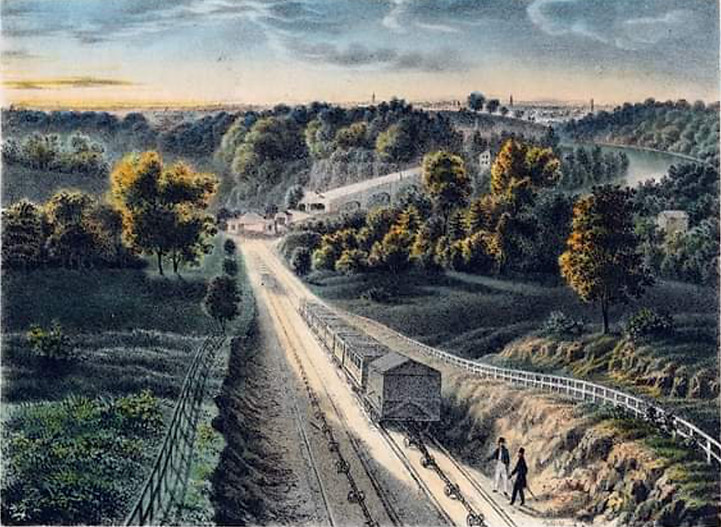
This sketch from 1838 shows the Belmont Inclined Plane, where in 1836 the George Washington, built by Norris, pulled a heavy load up a steep grade (7%) without assistance. This was a locomotive first and resulted in much new business for Norris.
Trains running along Pennsylvania Avenue (after 1898 the Callowhill Cut) heading west would cross over the Columbia Bridge, the covered bridge seen in the distance, and then be pulled up the incline using rope wrapped around a steam-engine driven pulley near the top of the incline. This incline was bypassed in 1850 with tracks running along the western bank of the Schuylkill River. The Columbia Bridge, now in its third incarnation, has concrete instead of stone arches. It is next to the grandstand for the crew events on Kelly Drive, two miles upriver from the Philadelphia Museum of Art.

A sketch from 1836 of the George Washington.
This is described as a 4-2-0 locomotive, meaning that there are 4 leading wheels, 2 larger driving wheels, and no trailing wheels under the trainman. The four leading wheels are on a chassis, or truck, that can pivot to allow the train to "flex" around turns. The roofed cab for the trainman, would, it seems, have to wait.

A Baldwin advertisement from 1838 plays down the achievement of the George Washington by touting the Baldwin engines' everyday performance for years, and "not a description of a single performance."
Norris and Baldwin were a block apart and both claimed to be the largest maker of locomotives in the country, if not the world.
The success of the George Washington in 1836 was small potatoes compared to what was going on further west at the same time. The State of Pennsylvania, in order to compete with the Erie Canal, granted charters to build a system of canals and railroads from the port of Philadelphia to Pittsburgh. This was called the Main Line of Public Works. By 1831 everything was completed except for a 36-mile stretch up and over the 3,000-foot tall Allegheny mountains between the canal's terminus in Hollidaysburg and the start of the next canal section in Johnstown. Norris locomotives were used to pull rail cars loaded with canal boats over the sections with gentle grades. For the steeper sections, stationary engines like the one at the Belmont incline were used, five engine houses on the east side of the mountains and five on the west side, for a total of ten portage inclines, numbered sequentially from the west to the east. This connecting rail section from Hollidaysburg to Johnstown, completed in 1834, was called the Allegheny Portage Railroad, and the Allegheny Portage Railroad National Historic Site in Gallitzin, Pennsylvania, pays homage to Norris locomotives.
The entire canal and portage railroad system would become obsolete by 1854 due to the combination of less steeply-pitched routes and more powerful locomotives. The Pennsylvania Railroad bought the tracks and the routes from the State of Pennsylvania, and towns along the eastern section of the former Main Line of Public Works outside Philadelphia make up Philadelphia's prestigious "Main Line" of today.
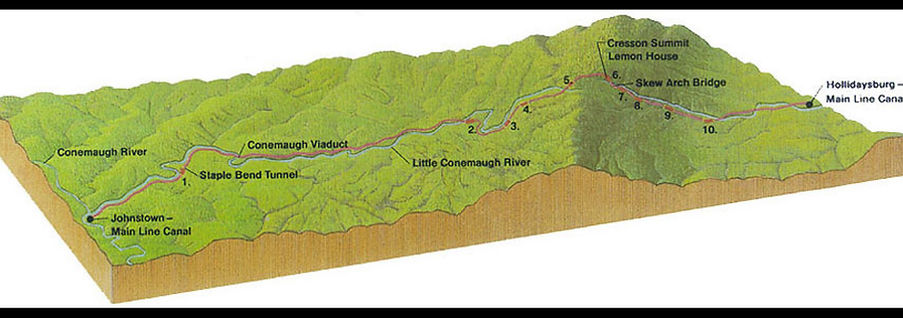
Topographical map of the Allegheny Portage Railroad.
This connecting railroad between the canal sections at Hollidaysburg to the east and Johnstown to the west completed the Main Line, which shortened the trip from Philadelphia to Pittsburgh from 28 to 4 days.
Note on the left the Staple Bend Tunnel at the summit of incline #1.
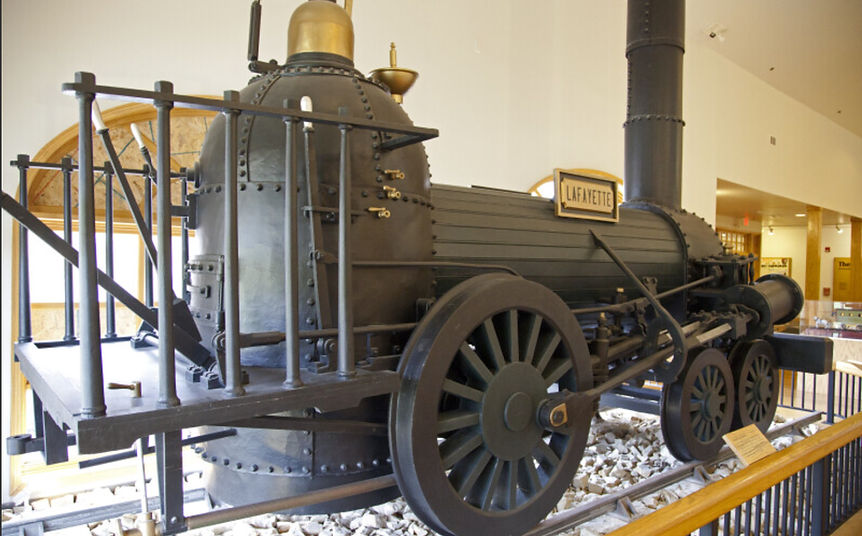
In the 1830's and 1840's, Norris was the leading manufacturer of locomotives in the United States. The locomotives' reputation as hill-climbers made them ideal for use on the gradual inclines between the stationary engine sites where pulley systems were used. At the Allegheny Portage Railroad National Historic Site you can view this full-scale wooden model of the Norris Lafayette locomotive. The original Lafayette was made in 1837 for the B&O Railroad. This model was made for the 1893 Chicago Columbian Exhibition. Adjacent to the Lafayette , but out of view in the photo, is a smaller model of the George Washington.
_jp.jpg)
An even better Lafayette replica is this working model built in 1927. It is in the B&O Railroad Museum in Baltimore, Maryland.
If you are a film buff, this locomotive may look familiar. It appeared in the following motion pictures: Wells Fargo (1937), Stand Up & Fight (1939), Disney's The Great Locomotive Chase (1956), and Steven Spielberg's Amistad (1997).
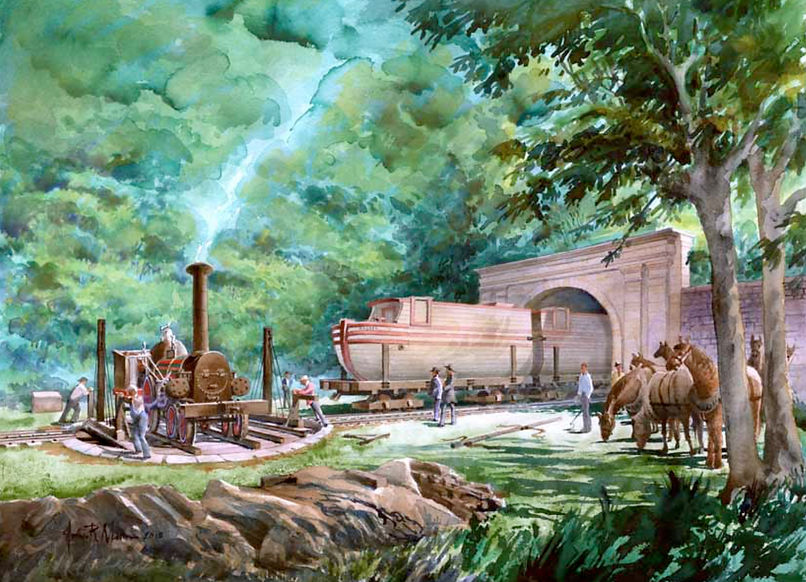
Painting of a Norris locomotive on a turntable being turned around to haul the canal boat eastward after being pulled up incline #1. The canal boats came in 2 to 4 sections, and these sections could be placed on individual rail cars for the rail segments of the Main Line. The cargo did not have to be unloaded and reloaded at each canal-rail junction. Also seen here is the Staple Bend Tunnel, the first railroad tunnel in the United States and only the third tunnel of any kind, the first two being tunnels for canals.
Painting and explanation from outside link here. For a good synopsis of the Portage Railroad see outside link here.
Norris had two factors going against his success. First, he had expensive personal tastes. While he should have been pouring profits into his fledgling business, he instead built a country estate and sponsored elaborate events that endeared him to Philadelphia society. Second, his business acumen could not overcome his lack of engineering skills or the high amplitude business cycles of the time. He brought in his brother Richard to manage the shop while the elder William traveled to Europe in search of sales. The latter effort was successful but not enough to prevent a creditor takeover in 1844, putting Richard and his brother Octavius in charge as William was squeezed out of the business, now to be called Norris Brothers Locomotive Works.
Octavius Norris left for Austria to help his brother William in a start-up there. Another brother, Septimus (presumably born right before Octavius), had joined the business, but management devolved to Richard and his son Latimer. In 1853 Richard paid off the creditors and forged ahead as Richard Norris & Son. Business was at its peak in 1855, the year United States Science magazine devoted almost its whole issue to the firm. Many of the pictures in the post you are reading are taken from excerpts of that article found in a 1984 Railroad History magazine article at JStor (article and free registration here).
In 1860, Richard, then 53 years old and with a net worth of $1.5 million, for unknown reasons decided to ratchet down the business. The Norris family had its roots in Maryland, and the Norris businessmen were sympathetic to the Southern cause in the Civil War. Local competitor Matthias Baldwin was an outspoken abolitionist, who fought for Black enfranchisement and was color-blind in his hiring. This cost him sales in the Southern states before and during the war, which orders Norris was more than happy to fulfill. After the Northern victory, the South was impoverished, and the North did not feel any loyalty to the Norris locomotives. In addition, Norris undoubtedly saw the Baldwin behemoth to his east as an impossible competitor. By 1867 the buildings had been vacated and his factory complex was split up and purchased in 1870 by the surrounding businesses.

David Kennedy's watercolor looking up 17th Street from Willow (Pennsylvania) Street in 1847 (credit here). David J. Kennedy (1816-1898) was the ticket agent for the Philadelphia and Reading Railroad's first passenger station at Broad and Cherry Streets. In 1861, he became the ticket agent at the second passenger station at Broad and Callowhill Streets. He painted in his spare time.

Sketch from 1855 looking north on 17th Street.
Hamilton Street is the east-west street (left-right) toward the bottom. Fairview (now Buttonwood) Street is just above the paired white buildings on the right. Morris (now Spring Garden) Street is in the distance. The perspective in this sketch stretches the actual lengths of the distant blocks.
The twin clerestoried buildings on the left can be seen as a cut-away diorama at the National Museum of American History in Washington, DC.

Norris erecting shop: cutaway diorama at the Smithsonian. Notice the progress on the locomotives from right to left on the first floor.
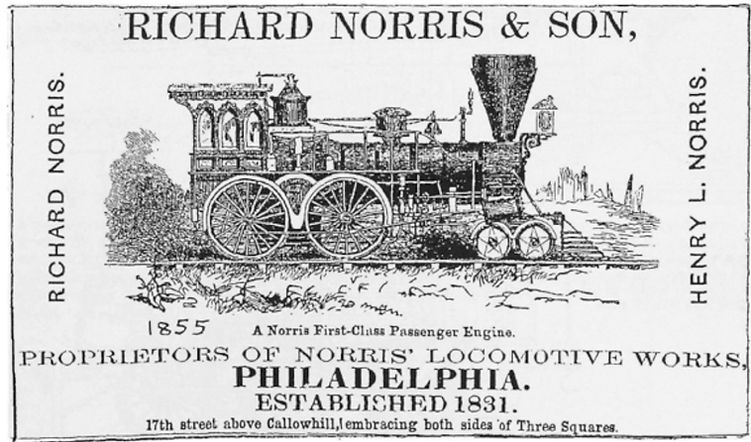
1855 ad for the Norris firm.
The address at bottom, stating "embracing both sides of Three Squares," meaning three blocks, is not quite true, as the lot opposite the steam hammer shop at the southwest corner of 17th and Hamilton (lower left building in image of shop complex above) was newly occupied by William Sellers & Company as of 1853.

Another sketch from 1855 showing a pair of buildings between Hamilton and Buttonwood Streets.
If you examine the 1868 image in the article on William Sellers & Company here, you will see that this pair of three-story buildings will only slightly be modified when taken over by Sellers.

The article from Railroad History magazine mentioned above shows sketches of each building's interior and text details of the workings. Here are sketches of the foundry and boiler shop in 1855.

This is an early daguerreotype from 1848 of the Tioga leaving the Norris shops.
This was a staged photograph: the trainmen are wearing their Sunday best and the carpet sellers along the rails have their wares on full display in the shop window and hanging from the windows, neither of which would be usual along the sooty rail route. This scene is probably along Pennsylvania Avenue (which some folks at that time called Willow Street) heading east (based on shadows).
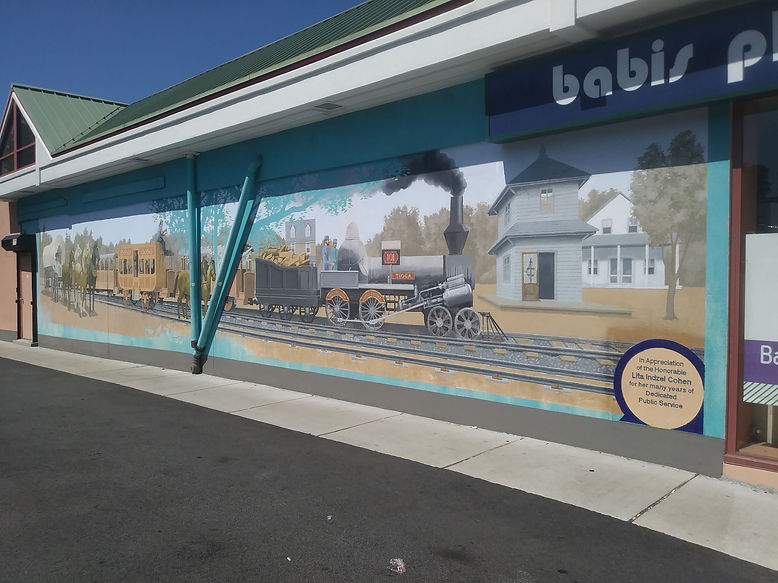
The Tioga image in the 1848 photo is included in this mural on the side of Hymie's Deli in Merion Station, just outside Philadelphia.
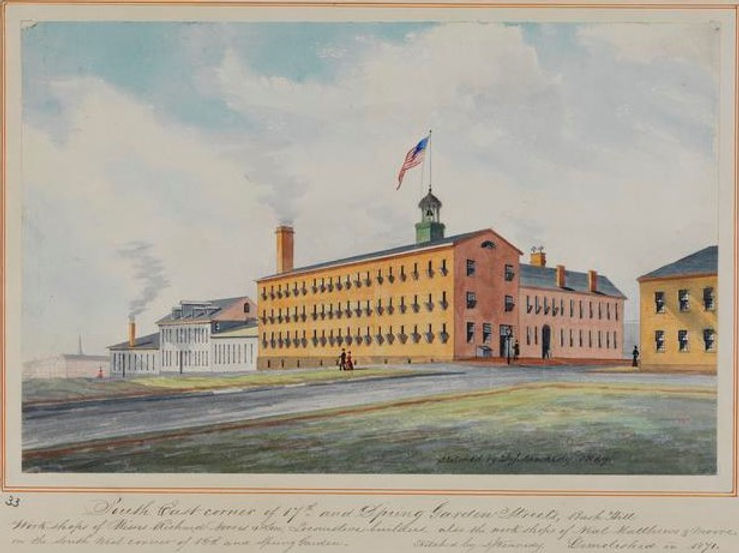
Another David Kennedy watercolor in 1869 looks southeast along Spring Garden Street with the focus on the southeast corner of 17th and Spring Garden Street. The Norris Works has been vacated for four years and would be mostly demolished by 1871 (credit here).
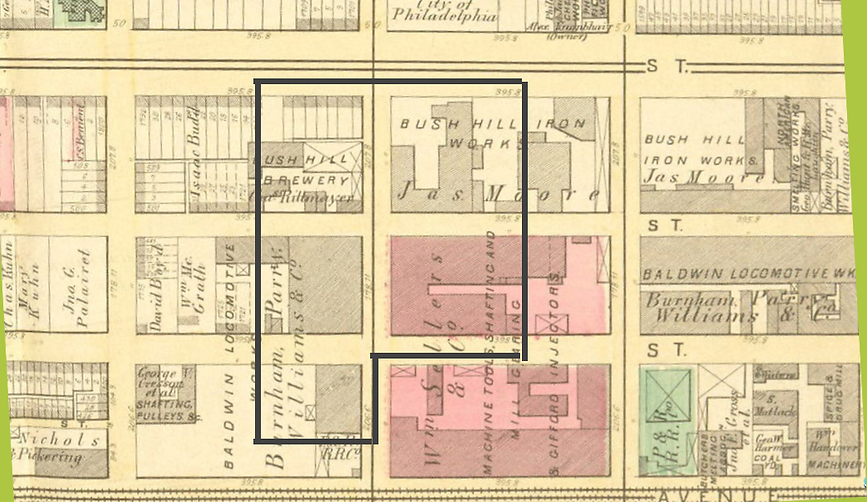
Portion of a City Atlas from 1875 showing no trace of the Norris Locomotive Works. The black box shows the maximum extent.

View north on 17th Street in 2020 from the bridge across the Callowhill Cut. What was once the heart of Norris Locomotive Works is now the heart of the Community College of Philadelphia.
Resources in addition to links in article:
https://hiddencityphila.org/2012/11/along-the-city-branch-the-forgotten-norris-locomotive-works/
http://www.lancasteratwar.com/2014/03/a-locomotive-built-in-lancaster-2-10-0.html
the Lancaster works restarted by two Norris brothers in 1863
https://www.jstor.org/stable/43517568?seq=1
Discussion of Norris locomotives in general, free sign up for resources
First of three-part series about Norris locomotives from 1890
authored by Joe Walsh, November 2020
bottom of page


